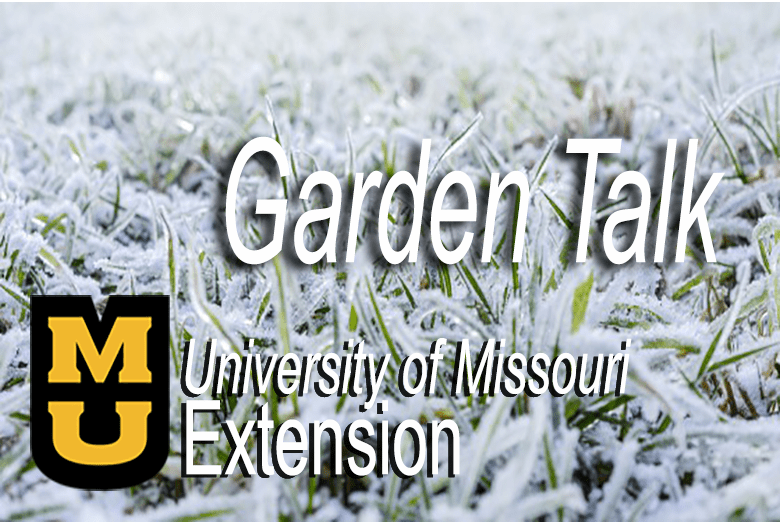
KJFM NEWS — Garden Talk is produced monthly at the Adair County University of Missouri Extension Center in Kirksville, Mo.
Vegetables/Fruits
By November, most vegetable gardens are finished producing, except maybe some root crops like parsnips and carrots. These crops get sweeter the cooler it gets. Some people leave carrots and parsnips in the ground over the winter, protected by a layer of straw mulch. Fall planted cool-season crops like broccoli, cauliflower, lettuce and spinach will tolerate temperatures down to 28 degrees or even colder, especially if protected with row covers.
Pick and store green tomatoes which will gradually ripen. Place them in a single layer. If piled into a box, one bad tomato can ruin the whole box of tomatoes. When the garden season has come to a close, remove spent plants from the garden. Plants can be burned or placed in a compost pile if not diseased. A soil test can be taken at this time, and nutrients applied according to what the test calls for. Gardens can be tilled and worked up at this time. Applying nutrients and organic matter in the fall, allows several months for it to break down and take effect in the soil, so it is ready for planting in the spring. It is not a good idea to take a soil test in May, apply nutrients and plant all in the same time frame.
I use the no-till method on my gardens. This has greatly reduced the amount of erosion that occurs during heavy rains, and I’ve built up the organic matter level over time with this method. Each fall, I remove the spent plants and burn them in the garden or put them in a brush pile. I leave the asparagus ferns until spring. In March, I burn them off. In the spring, I plant directly into the soil. Fresh straw mulch is used around plants to decrease the chance of getting disease.
Strawberry buds need winter protection. Apply 3-6 inches of straw over the bed in late November or early December after several frosts. According to researchers, strawberry crowns without mulch can suffer damage at temperatures below 12°F. I have lost unprotected strawberry plants at 16 degrees. Mulching protects strawberry plants from the cold by providing insulation, acting as a barrier against drying winds, and protecting plants from soil heaving which results from freeze/thaw cycles during the winter. Wrap young or newly planted fruit trees with a light- colored tree wrap to protect them from Southwest Injury, a type of winter injury. A barrier may also need to be placed around trees to protect them from rabbits and deer.
Ornamentals/Lawns
Often potted plants brought in from outdoors go through shock. The leaves may turn yellow and drop. This is common. I’ve had it happen many times to plants I’ve overwintered, and they leaf out just fine the following spring. Check these plants regularly for insects like aphids, mealy bugs and scale, and treat as needed.
Clean out flower beds, removing leaves that have fallen, as this can smother plants over the winter. Remove dead annuals from containers and beds, and cut back foliage on perennials after a freeze if you desire. I leave dead foliage on seed producing plants like coneflowers, Echinacea sp., and Black-eyed Susans, Rudbeckia sp., as food source for winter birds. Plants that add color and interest to the landscape like ornamental grasses, should be left until spring. Do not cut back dead foliage on chrysanthemums. They overwinter better if not cut back until spring. Apply a 3-4 inch-layer of mulch around mums and other perennials to provide winter protection. I like to use bark chips or cypress mulch in my beds. In northeast Missouri, cannas, gladiolus, dahlias and any other tender perennials should be dug and stored in a cool, dry place for winter. Some of these will over winter in southern parts of our state. Ornamental kale, pansies and snapdragons are cool-season annuals that may survive well into December during a mild fall. These plants add a splash of color to a landscape going into winter. Spring bulb flowers like tulips and daffodils can be planted until the ground freezes. It is very important to clean and oil garden tools before storing them away for winter. Clean out garden sheds, remove dirt and debris, and eliminate over-wintering insects like squash bugs that may be trying to find a place to spend the winter. Drain water hoses, and bring in yard ornaments to prevent freezing and cracking.
Trees/Shrubs
Rake up leaves that have fallen from trees and add to the compost pile. They will decompose and can be added as organic matter to gardens in the spring. Although, shredded leaves will decompose faster than whole leaves. Leaves on the lawn can be mowed over instead of bagged to add organic matter to the lawn.
Late fall (November-December) is a good time to prune ornamental shade trees. Prune low hanging branches, diseased or broken branches and crossing or rubbing branches. Do not prune fruit trees at this time. November is a good time to fertilize shade trees and ornamental shrubs. Applications should be made approximately one month after a killing frost. A fresh layer of mulch can be applied around trees/shrubs at this time using the donut method. Mulch rings should never look like a volcano. Wrap young or newly planted trees like maples and flowering crabapples with a light-colored tree wrap to protect them from Southwest Injury. Damage such as cracks in the trunk and peeling bark become visible most often during the late winter/early spring.
Holiday Plants
The holidays are almost upon us. Just a few weeks after reading this newsletter, it will be time to put up the Christmas tree and decorate both indoors and out. Some families have the tradition of going to a tree farm after Thanksgiving dinner and selecting the perfect tree for their family. This is a fun tradition for my family. We load up, sometimes with the dog, and head out to a tree farm south of Kirksville. There is a log cabin at the entrance that customers can go in, with a fire burning in the wood stove, and Christmas items to look at and purchase. I feel like I’ve stepped back into the 1880s. Unfortunately, this is the last year for that Christmas tree farm. The family is retiring from tree farming.
If you cut your own tree from a local tree farm, it will last over a month in your house if properly cared for, versus a retail outlet, where 2-3 weeks may have already passed by the time you purchase it. Scotch pines are common in the Midwest and on local Christmas tree farms. They have short needles and their thick branches that make them ideal for holding large, heavy ornaments. Check the tree’s water reservoir daily, and provide water if needed. Never let the reservoir get empty and tree dry out. Dry trees are a fire hazard.
If you purchase or receive a poinsettia for the holidays, place it in a bright window and do not overwater it. Watering it once a week or at first signs of wilting should be adequate. The number one cause of death of poinsettias in homes is root rot caused from overwatering.
